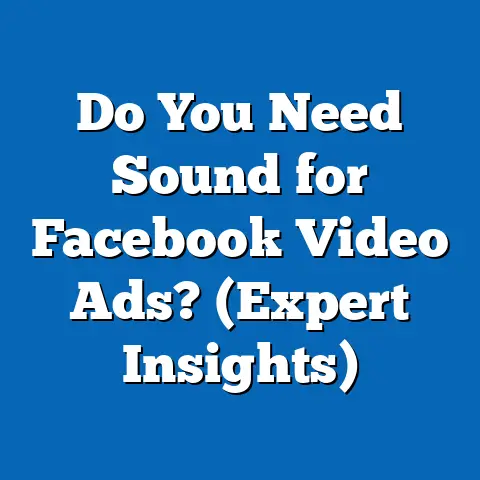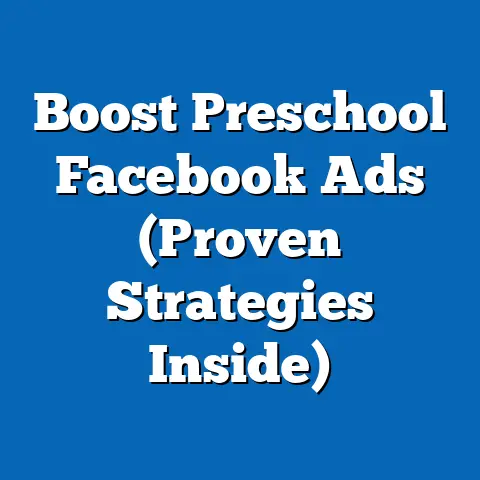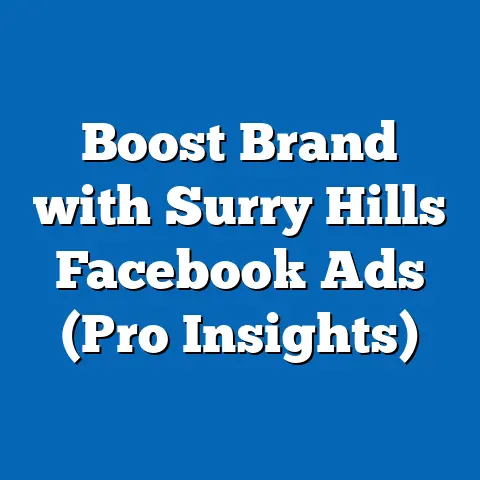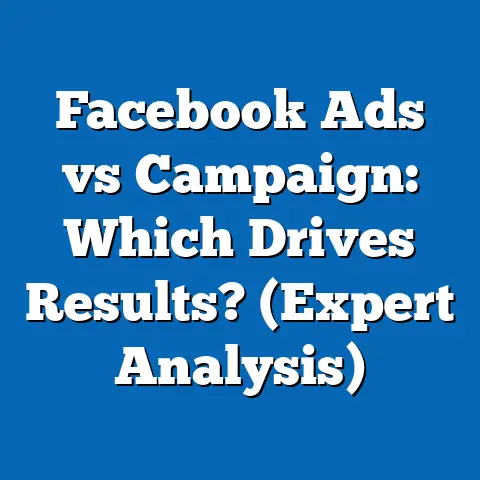Reviving Facebook Ads: Strategies for Success (Expert Insights)
In the ever-evolving realm of digital advertising, one thing remains constant: the need for innovation. I’ve witnessed firsthand how quickly strategies that once worked like a charm can become outdated. And when it comes to Facebook Ads, this rings particularly true. Over the years, Facebook has not only adapted but transformed its advertising platform, responding to shifts in consumer behavior, technological advancements, and the ever-changing digital marketing landscape. This constant evolution is why it’s vital to stay ahead of the curve and embrace innovation to achieve success with Facebook Ads.
I remember when simply boosting a post to a broad audience seemed like an effective strategy. Now, with increased competition and sophisticated algorithms, that approach is akin to shouting into the void. That’s why I’m excited to share some expert insights into effective strategies for reviving and optimizing your Facebook Ads. This article will guide you through understanding the current landscape, harnessing advanced targeting, crafting creative content, leveraging advanced ad formats, and measuring your success to continuously optimize your campaigns. Let’s dive in!
Section 1: Understanding the Current Landscape of Facebook Ads
The world of Facebook Ads is a dynamic and ever-changing ecosystem. To truly revive your ad strategy, it’s crucial to understand the current landscape, including recent trends, statistics, and the challenges that advertisers face today.
Currently, Facebook remains a powerhouse in digital advertising, with billions of active users. This sheer scale offers incredible opportunities for businesses to reach diverse audiences. However, this also means increased competition, making it harder to stand out and achieve a high return on investment (ROI). According to recent data, while ad spending on Facebook continues to rise, so does the cost per click (CPC) and cost per impression (CPM). This means advertisers need to be smarter and more strategic with their campaigns to justify the investment.
One of the biggest shifts in recent years has been the impact of privacy changes, most notably Apple’s iOS updates. These changes have limited the ability to track users across apps, significantly impacting the effectiveness of traditional retargeting strategies. I recall the initial panic among many marketers when these updates rolled out. Many of us had relied heavily on pixel data to track conversions and optimize campaigns. However, this challenge has forced advertisers to become more creative and focus on first-party data, contextual targeting, and building direct relationships with their customers.
Takeaway: The current landscape of Facebook Ads is competitive and requires a strategic approach. Privacy changes have made it essential to focus on first-party data, contextual targeting, and understanding your audience deeply. The next step is to explore how to harness advanced targeting techniques to reach your ideal customers effectively.
Section 2: Harnessing Advanced Targeting Techniques
To truly revive your Facebook Ads, mastering advanced targeting techniques is essential. Gone are the days of broad, generic targeting. Today, the key to success lies in reaching the right people with the right message at the right time. Facebook offers a wealth of advanced targeting options that, when used effectively, can significantly improve your ad performance and ROI.
One of the most powerful tools in your arsenal is Custom Audiences. These allow you to target specific groups of people based on your existing data sources. This can include:
- Customer Lists: Uploading a list of your existing customers (email addresses, phone numbers) allows you to target them directly on Facebook. This is perfect for promoting new products, offering exclusive deals, or re-engaging with past customers. I’ve personally seen great success using customer lists to target high-value customers with personalized offers.
- Website Visitors: Using the Facebook Pixel, you can create a custom audience of people who have visited your website or specific pages. This allows you to retarget them with relevant ads based on their browsing behavior. For example, if someone viewed a product page but didn’t make a purchase, you can retarget them with an ad featuring that product.
- App Users: If you have a mobile app, you can create a custom audience of people who have downloaded or used your app. This allows you to re-engage them with new features, promotions, or reminders to use the app.
- Engagement: This allows you to target people who have interacted with your Facebook or Instagram content, such as liking your page, watching your videos, or engaging with your posts. This is a great way to reach people who are already familiar with your brand.
Another powerful targeting option is Lookalike Audiences. These allow you to find new people who are similar to your existing customers or website visitors. Facebook uses its algorithm to analyze the characteristics of your source audience (e.g., your customer list) and identify other users who share similar demographics, interests, and behaviors. This is a fantastic way to expand your reach and find new potential customers who are likely to be interested in your products or services.
Finally, Facebook offers a wide range of detailed targeting parameters based on demographics, interests, behaviors, and more. This allows you to refine your targeting and reach specific groups of people with highly relevant ads. For example, you can target people who are interested in specific hobbies, have certain job titles, or have recently purchased a home.
Example:
I once worked with a local bakery that wanted to increase its cake orders for birthdays. Instead of running generic ads to everyone in the city, we used advanced targeting techniques to reach specific demographics. First, we created a custom audience of past customers who had ordered cakes before. Then, we created a lookalike audience based on that customer list to reach new potential customers who were similar to our existing ones. Finally, we used detailed targeting to target people who were interested in baking, parties, and gift-giving. The result was a significant increase in cake orders and a much higher ROI compared to their previous generic campaigns.
Takeaway: Advanced targeting techniques like Custom Audiences, Lookalike Audiences, and detailed targeting parameters are essential for reviving your Facebook Ads. By reaching the right people with the right message, you can significantly improve your ad performance and ROI.
Section 3: Creative Content Strategies
In the bustling digital marketplace, your ad’s content is your loudest advocate. It’s not just about having a product; it’s about telling its story in a way that captivates and converts. Innovative and engaging content is the lifeblood of high-performing ads.
Crafting Compelling Ad Copy and Visuals:
- Know Your Audience: Tailor your message to resonate with their specific needs and desires. Use language they understand and address their pain points directly.
- Highlight the Benefits: Focus on what your product or service can do for the customer, rather than just listing its features.
- Use Strong Visuals: High-quality images and videos are essential for capturing attention. Make sure your visuals are relevant to your message and visually appealing.
- Keep it Concise: People scroll quickly, so get straight to the point. Use short, punchy sentences and avoid jargon.
- Include a Clear Call to Action (CTA): Tell people exactly what you want them to do, whether it’s “Shop Now,” “Learn More,” or “Sign Up.”
The Power of Video:
Video has become a dominant force in the digital landscape, and Facebook is no exception. Video ads tend to perform significantly better than static image ads, as they are more engaging and can convey more information in a short amount of time.
- Grab Attention Quickly: The first few seconds of your video are crucial. Use a captivating hook to draw viewers in.
- Keep it Short and Sweet: Aim for videos that are 15-30 seconds long.
- Tell a Story: Use storytelling to connect with your audience on an emotional level.
- Use Captions: Many people watch videos with the sound off, so make sure your video is understandable with captions.
The Art of Storytelling:
Storytelling is a powerful way to connect with your audience and build a strong brand identity. When crafting your ads, think about how you can tell a story that resonates with your target audience. This could be a story about your brand’s origins, a customer success story, or a story that highlights the benefits of your product or service.
User-Generated Content (UGC):
UGC is content created by your customers, such as reviews, testimonials, and photos or videos of them using your products. UGC is incredibly powerful because it’s authentic and trustworthy. Featuring UGC in your ads can significantly boost your credibility and drive conversions.
A/B Testing: The Key to Optimization:
A/B testing, also known as split testing, is the process of comparing two versions of your ad to see which one performs better. This involves creating two different ads with variations in the headline, image, copy, or CTA, and then running them simultaneously to see which one generates more clicks, conversions, or engagement.
Example:
I worked with an e-commerce brand that was struggling to get traction with their Facebook Ads. After analyzing their existing campaigns, I realized that their ad creative was generic and uninspired. We decided to focus on creating more engaging content, including high-quality product photos, videos showcasing the product in action, and customer testimonials. We also started A/B testing different headlines, ad copy, and CTAs to see what resonated best with their target audience. The results were remarkable. Their click-through rates (CTR) increased by over 200%, and their conversion rates tripled.
Takeaway: Creative content is the key to driving ad performance. Craft compelling ad copy and visuals, leverage the power of video, embrace storytelling, and incorporate user-generated content. Remember to continuously A/B test your ads to optimize your content strategies.
Section 4: Utilizing Facebook’s Advanced Ad Formats
Facebook isn’t just about single-image ads anymore. To truly engage your audience and drive conversions, you need to explore the diverse and advanced ad formats that the platform offers. Each format has its own strengths and is best suited for different objectives and target audiences.
Here’s a breakdown of some of the most effective advanced ad formats:
- Carousel Ads: These ads allow you to showcase multiple images or videos within a single ad unit. Each image or video has its own headline, description, and link, allowing you to highlight different products, features, or benefits. Carousel ads are perfect for e-commerce businesses looking to showcase their product catalog or for brands looking to tell a story through a series of visuals. I’ve seen carousel ads work wonders for showcasing different angles of a product or highlighting various use cases.
- Collection Ads: Designed specifically for mobile devices, Collection Ads combine a hero image or video with a selection of related products. When users click on the ad, they are taken to a full-screen Instant Experience (formerly known as Canvas) where they can browse the products and make a purchase. Collection Ads are ideal for e-commerce businesses looking to create a seamless and visually engaging shopping experience on mobile.
- Instant Experience Ads: These immersive, full-screen ads load instantly on mobile devices, providing a seamless and engaging experience for users. Instant Experiences can include a variety of content, such as images, videos, carousels, and forms. They are perfect for telling a brand story, showcasing a product demo, or driving conversions. The key is to create an experience that is visually appealing, interactive, and provides value to the user.
- Lead Ads: These ads are designed to capture leads directly on Facebook without sending users to an external landing page. Lead Ads include a pre-filled form that users can submit with just a few taps, making it easy for them to provide their contact information. Lead Ads are ideal for businesses looking to generate leads for sales, email marketing, or other purposes. They are especially effective for mobile users who may be hesitant to fill out a form on a traditional landing page.
- Playable Ads: These interactive ads allow users to try out a game or app before downloading it. Playable Ads are highly engaging and can significantly increase the number of downloads and installs. They are perfect for mobile game developers and app marketers looking to acquire new users.
Example:
A clothing retailer I worked with was struggling to drive online sales through their traditional single-image ads. We decided to experiment with Collection Ads to create a more visually appealing and engaging shopping experience on mobile. We created a Collection Ad that featured a hero image of a model wearing their latest collection, along with a selection of related products. When users clicked on the ad, they were taken to a full-screen Instant Experience where they could browse the products, view details, and make a purchase. The result was a significant increase in online sales and a much higher ROI compared to their previous campaigns.
Takeaway: Facebook offers a wide range of advanced ad formats that can help you engage your audience and drive conversions. Experiment with different formats to see what works best for your business and target audience. Remember to tailor your content and messaging to each format to maximize its effectiveness.
Section 5: Measuring Success and Ad Performance Optimization
You’ve crafted compelling ads, targeted the right audience, and chosen the perfect ad format – but how do you know if your efforts are paying off? Measuring success and continuously optimizing your ad performance is crucial for maximizing your ROI and achieving your marketing goals.
Key Performance Indicators (KPIs):
- Reach: The number of unique people who saw your ad.
- Impressions: The number of times your ad was displayed.
- Click-Through Rate (CTR): The percentage of people who saw your ad and clicked on it.
- Cost Per Click (CPC): The amount you pay each time someone clicks on your ad.
- Conversion Rate: The percentage of people who clicked on your ad and completed a desired action, such as making a purchase or filling out a form.
- Cost Per Acquisition (CPA): The amount you pay to acquire a new customer or lead.
- Return on Ad Spend (ROAS): The revenue you generate for every dollar you spend on advertising.
Utilizing Facebook Ads Manager:
Facebook Ads Manager is your central hub for tracking and analyzing your ad performance. It provides a wealth of data and insights that can help you understand what’s working and what’s not.
- Track Key Metrics: Use Ads Manager to track your KPIs and monitor your ad performance over time.
- Analyze Demographics: See which demographics are responding best to your ads.
- Identify Top-Performing Ads: Determine which ads are generating the most clicks, conversions, and engagement.
- Track Conversions: Set up conversion tracking to see how many sales, leads, or other desired actions are being generated by your ads.
Strategies for Optimizing Ad Campaigns:
- A/B Testing: Continuously A/B test your ads to see what resonates best with your audience. Experiment with different headlines, images, ad copy, and CTAs.
- Audience Refinement: Refine your targeting based on performance data. Exclude audiences that are not responding well to your ads and focus on those that are generating the most conversions.
- Budget Adjustments: Adjust your budget based on performance. Allocate more budget to top-performing ads and reduce budget for underperforming ads.
- Retargeting: Retarget people who have interacted with your website or Facebook page. Show them ads that are relevant to their past behavior.
- Landing Page Optimization: Make sure your landing pages are optimized for conversions. Ensure they are relevant to your ads, have a clear call to action, and are easy to navigate.
Example:
I was working with a client who was running a Facebook Ads campaign to promote their online course. After analyzing their ad performance, I noticed that their CTR was low and their CPA was high. We decided to A/B test different headlines and ad copy to see what resonated best with their target audience. We also refined their targeting to focus on people who were interested in specific topics related to their course. Finally, we optimized their landing page to make it more user-friendly and improve the conversion rate. The result was a significant increase in CTR, a decrease in CPA, and a much higher ROI for their campaign.
Takeaway: Measuring success and continuously optimizing your ad performance is crucial for maximizing your ROI. Track your KPIs, utilize Facebook Ads Manager, and implement strategies for optimizing your ad campaigns based on performance data.
Conclusion
Reviving your Facebook Ads strategy in today’s dynamic digital landscape requires a commitment to innovation and continuous learning. By embracing advanced targeting techniques, crafting engaging content, utilizing diverse ad formats, and continuously measuring and optimizing performance, you can successfully navigate the evolving landscape and achieve your marketing goals.
I’ve seen firsthand how these strategies can transform struggling campaigns into high-performing engines of growth. The key is to stay curious, experiment with new approaches, and never stop learning.
So, I encourage you to take the insights shared in this article and apply them to your own Facebook Ads strategies. Don’t be afraid to try new things and see what works best for your business. With a strategic approach and a commitment to innovation, you can unlock the full potential of Facebook Ads and achieve remarkable results. Now go out there and revive your Facebook Ads!






